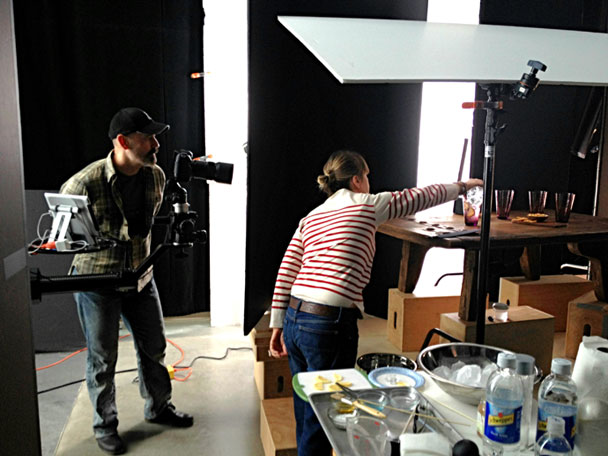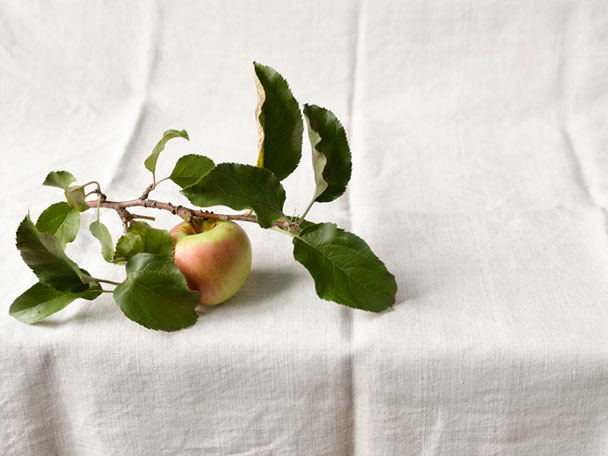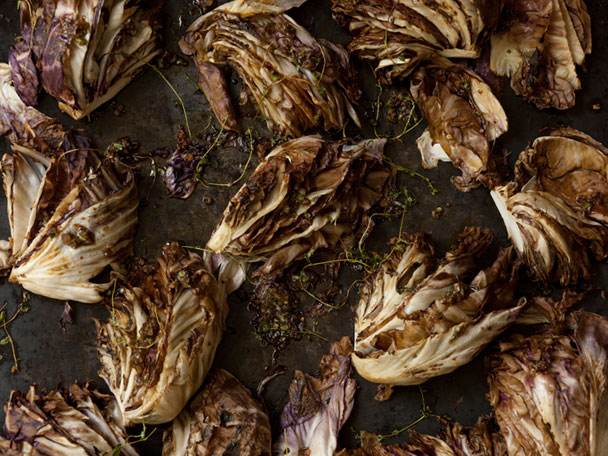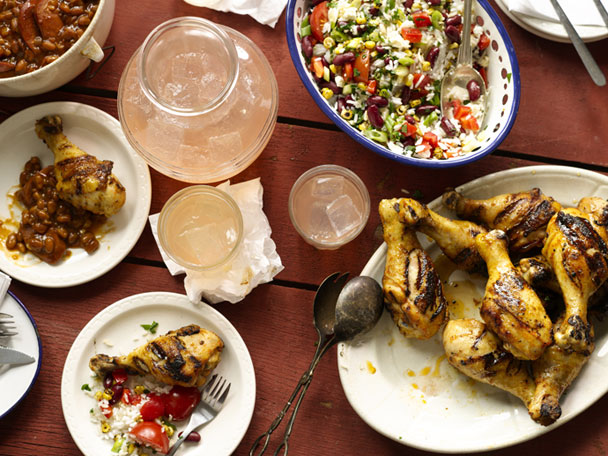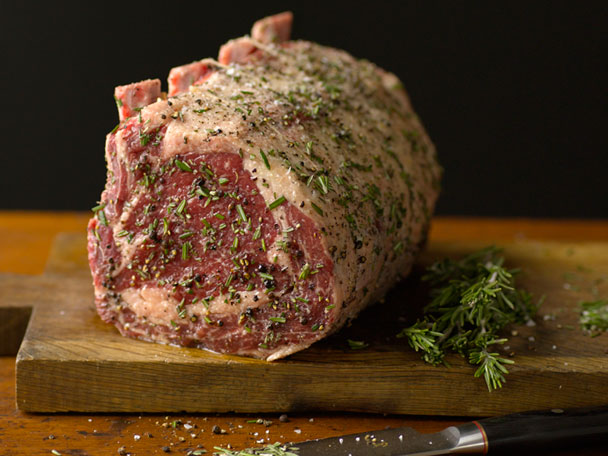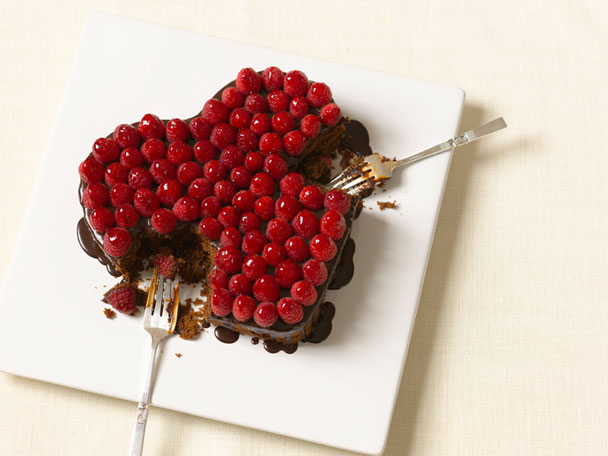Click picture to advance the slideshow.
It’s 9:30 a.m. and Ben Fink is leaning over his camera composing the first shot of the day. The subject: a coconut layer cake.
“Hit it with the jelly beans.”
Maggie Ruggiero, the food stylist, is poised over the pearly-white cake. She opens the palm of her hand, and the jelly beans cascade in a rainbow shower. They plunge through the pristine coconut shavings on the icing and come to rest, splattered across the cake.
Fink pauses for a moment and then straightens up. He steps away from his camera while simultaneously reaching back and nonchalantly pressing the shutter button.
He takes a few short steps to an iPad that serves as his monitor. The client is already there, waiting for the image to appear. Fink joins him. They both bend forward to take a closer look.
“The jelly beans are lost in the peaks and valleys,” says the client. “But there is a nice wisp of coconut.”
Fink adjusts the camera arm for a higher angle. He takes another shot.
“Those jelly beans seem very Halloweeny,” says the client. “I’m seeing a lot of yellow.”
So begins Day 1 of a cookbook shoot. The schedule dictates 50 images in five days, which means 50 different recipes to cook, prop, and shoot, or 10 completed images each day. It’s a punishing schedule, but nothing Fink can’t handle.
The lensman has photographed more than 35 cookbooks, including the James Beard Award–winning Artisan Baking Across America by Maggie Glazer (Artisan, 2000) and Screen Doors and Sweet Tea by Martha Foose (Clarkson Potter, 2008). From a childhood in poverty in the tough Frayser section of Memphis in the 1970s, Fink made, as he tells it, a near miraculous escape from what might have been an extremely limited life. He made his way to New York City, where he worked hard, learned on the job, earned his stripes shooting for food magazines, and eventually attracted the attention of some of the industry’s biggest publishers and celebrity chefs. Today, Fink counts Rachael Ray, Bobby Flay, and Jacques Pépin among the long list of clients who trust his eye to capture their creations in the pages of their cookbooks.
Dressed in jeans and a black T-shirt and sporting a rakish goatee, Fink has a relaxed but commanding presence. His working style is unfussy, pragmatic, and quick. He can shoot a roast chicken in two minutes after it has come out of the oven. He’s also hands-on: If he doesn’t like the way the bird is sitting in the pan or on the plate, he’ll step out from behind the camera and adjust it himself.
Twenty years ago, things were different. In order to tighten the skin of a chicken and to give it a glow, a trick of the trade was to pre-boil, dust with detergent, and apply Kitchen Bouquet before putting the chicken in the oven. The fashion now is less artificial and far less controlled. But some tricks are still used, including a spritz of water or a dab of Karo syrup to make a dry surface glisten. But Fink prefers not to resort to such methods. He wants his photographs to look authentic and the food to remain edible.
Fink doesn’t work alone. Like a film director, he has a crew, and each person in that crew has a well-defined job. Sarah Smart, the prop stylist, organizes a vast array of objects chosen specifically for the shoot: gingham napkins laid out in lines of blues, reds, and browns, rows of flatware (ranging from antique to tastefully generic), ramekins in all shapes and sizes, and a collection of trays. Her job is to set the scene (the appropriate napkin, the well-chosen fork, the overall color palette), but her work doesn’t end once the shoot begins. If Fink isn’t happy with a reflection on a pie stand or the fold of a napkin, Smart has to quickly provide an alternative.
Ruggiero, the food stylist, commands the kitchen. The day’s recipes are taped on the wall above her prep station. The Southern buttermilk biscuits have to come out of the oven at the exact moment Fink needs them. Too early, and the biscuits will go cold, scuttling the best-laid plans for melting butter and honey on top; too late, and the shoot is delayed. Ruggiero shuffles around the set like an endearing aunt preparing a family meal. But her manner belies an exacting professionalism: As the butter begins to congeal atop one of the biscuits, she whips out a mini propane lighter and gives it a blast.
Fink’s team all bring their individual expertise and professionalism to the table, but in an age when food imagery has become ubiquitous—in print, online, and in social media—the best photographers must, more than ever, make their mark. The use of natural light is the defining aspect of Fink’s work. For today’s shoot, he has rented a studio in midtown Manhattan with a bank of windows that overlook the industrial west side and the Hudson River beyond. Rather than move his set around the studio space as the light shifts throughout the day, he has erected a clever system of scrims and foam boards to “shape the light,” as he says. It makes sense that Fink admires the chiaroscuro of Renaissance paintings and the layered compositions of Dutch 17th-century still lifes, with their bowls of ripe fruit, silvery oysters, and gleaming china.
It is midafternoon now, and the shoot has moved on to Buffalo chicken tenders. Honey-colored and glistening, they are jauntily skewered on sticks and set on bone-white dishes. Tall glasses of iced tea round out the overall composition.
Client: “Are there too many glasses?”
Fink: “It looks like a party.”
Client: “What about all those seeds in the lemon?”
Fink: “We can take them out.”
Client: “Do you think we need more tea?”
Fink: “Let’s change the ice out. It’s looking icky.”
Fink peers briefly through the lens of his camera and pushes the shutter. “Give it some curve,” he declares somewhat mysteriously.
Although speed, authenticity, and the use of natural light are the hallmarks of Fink’s method, there is one other secret weapon: Jeff Kavanaugh. Kavanaugh sits in a dark, enclosed cubicle directly behind the camera setup. In front of him are glowing computer screens. As soon as Fink shoots an image, it appears on one of Kavanaugh’s monitors. When Fink says, “Give it some curve,” that’s code meaning that the shot may be a keeper. It’s also Kavanaugh’s cue to instantly set to work darkening colors, fixing imperfections (retouching a chipped plate, for example), and, most impressively, layering the images.
To layer Fink’s shot of iced tea, Kavanaugh toggles back and forth between two shots, lines up the glasses of iced tea, masks out everything except the ice in one, and “paints” that ice cube into the second. This, he says, “allows the ice to show from one layer to the next.” It’s like Photoshopping on the fly. Of the 30 or so shots of the Buffalo chicken tenders, Kavanaugh will make one image by layering together the best elements of all the takes. He then makes a small work print, brings it out to the studio, and tacks it up on the wall. No contact sheets, no mind-boggling array of choices. It’s the final image.
Evening approaches, and outside the studio, the red taillights of cars waiting to enter the Lincoln Tunnel glow moodily in the darkening light. But Fink is still shooting, and the photographs of a pulled pork sandwich he’s now turning out look as if they were taken at 2:00 on a sunny summer afternoon. His exposure time is up to eight seconds, and he is working with concentrated speed. Smart and Ruggiero keep out of Fink’s way as he gives a plate a quick quarter-turn, tucks a piece of pork back under the bun, and angles a bottle of beer. He is—still—clearly enjoying himself.
Forever inspired by the arts, Fink studied music when he was young, taking an early shine to Bach. And there is indeed something calm and precise, even lyrical, in the way Fink composes the last shots of the day in the fading light.
The client is now on the phone, his attention shifted to making dinner plans. But Fink is still immersed in making this final shot as beautiful as it can be. He nudges a plate a quarter of an inch, refolds a corner of a napkin, and checks his exposure. He bends over his camera, glances up, and then says softly, “I can’t believe I get to do this for a living.”
Adam Harrison Levy is a documentary filmmaker, a contributing writer for Design Observer, and a teacher at New York’s School of Visual Arts. His most recent story for Gourmet Live featured celebrities’ most prized kitchen utensils.

